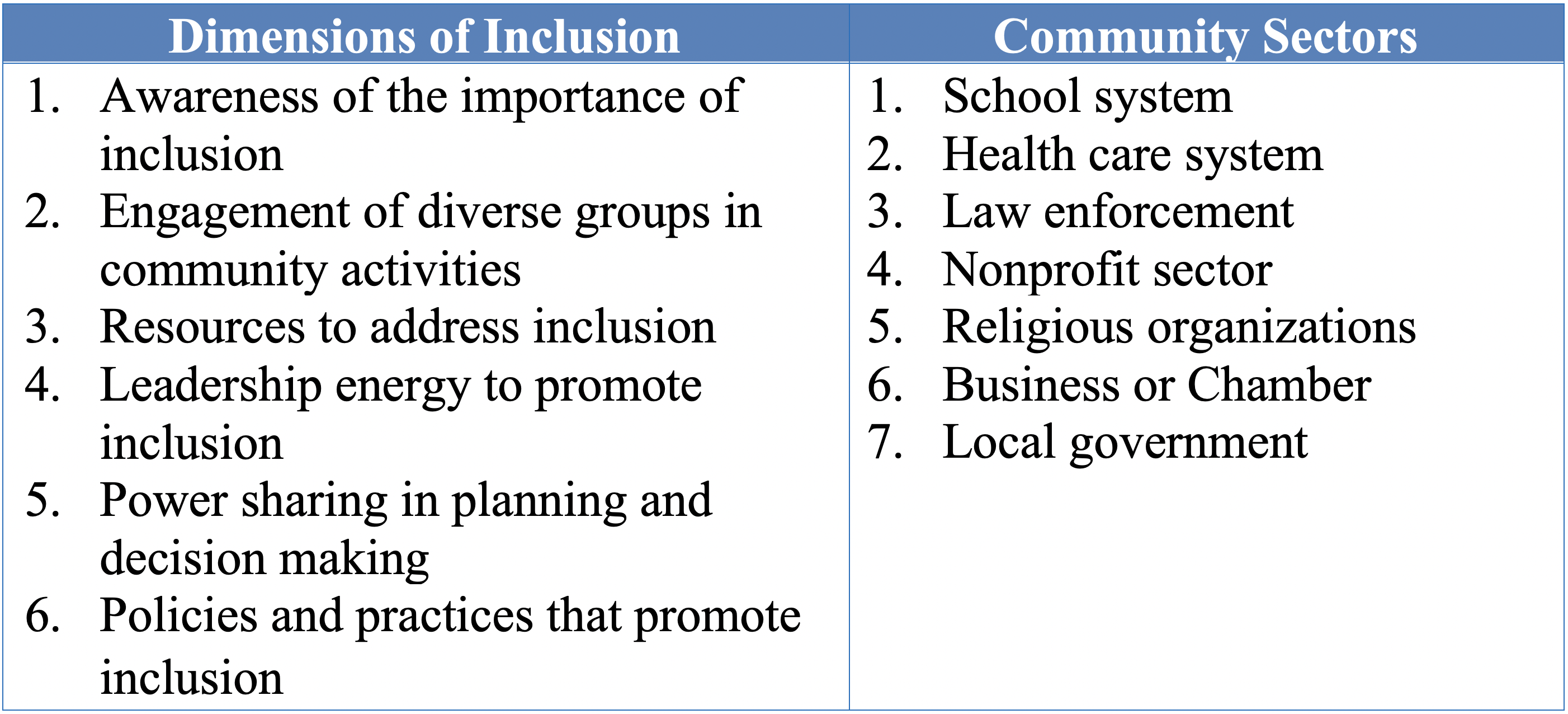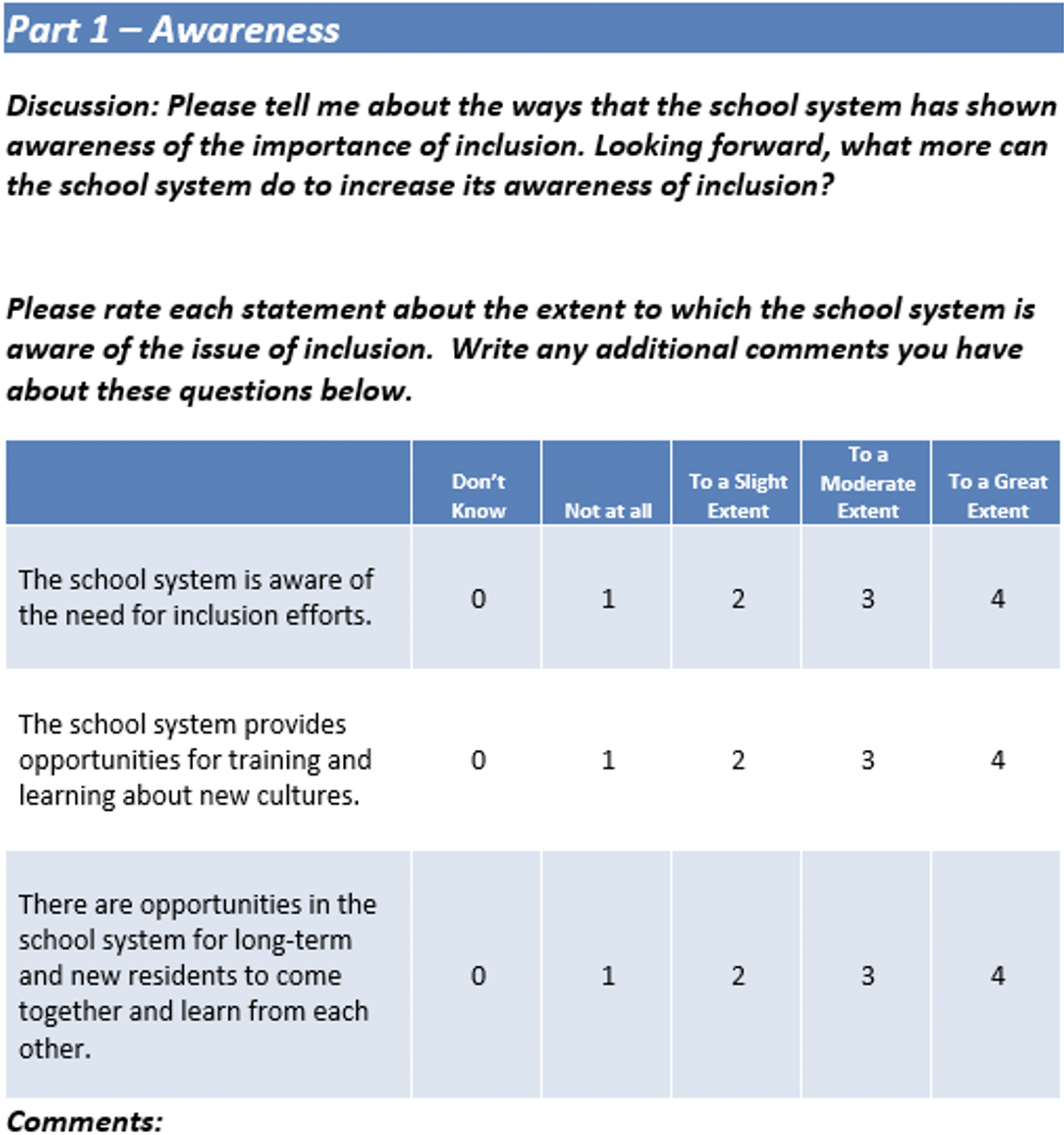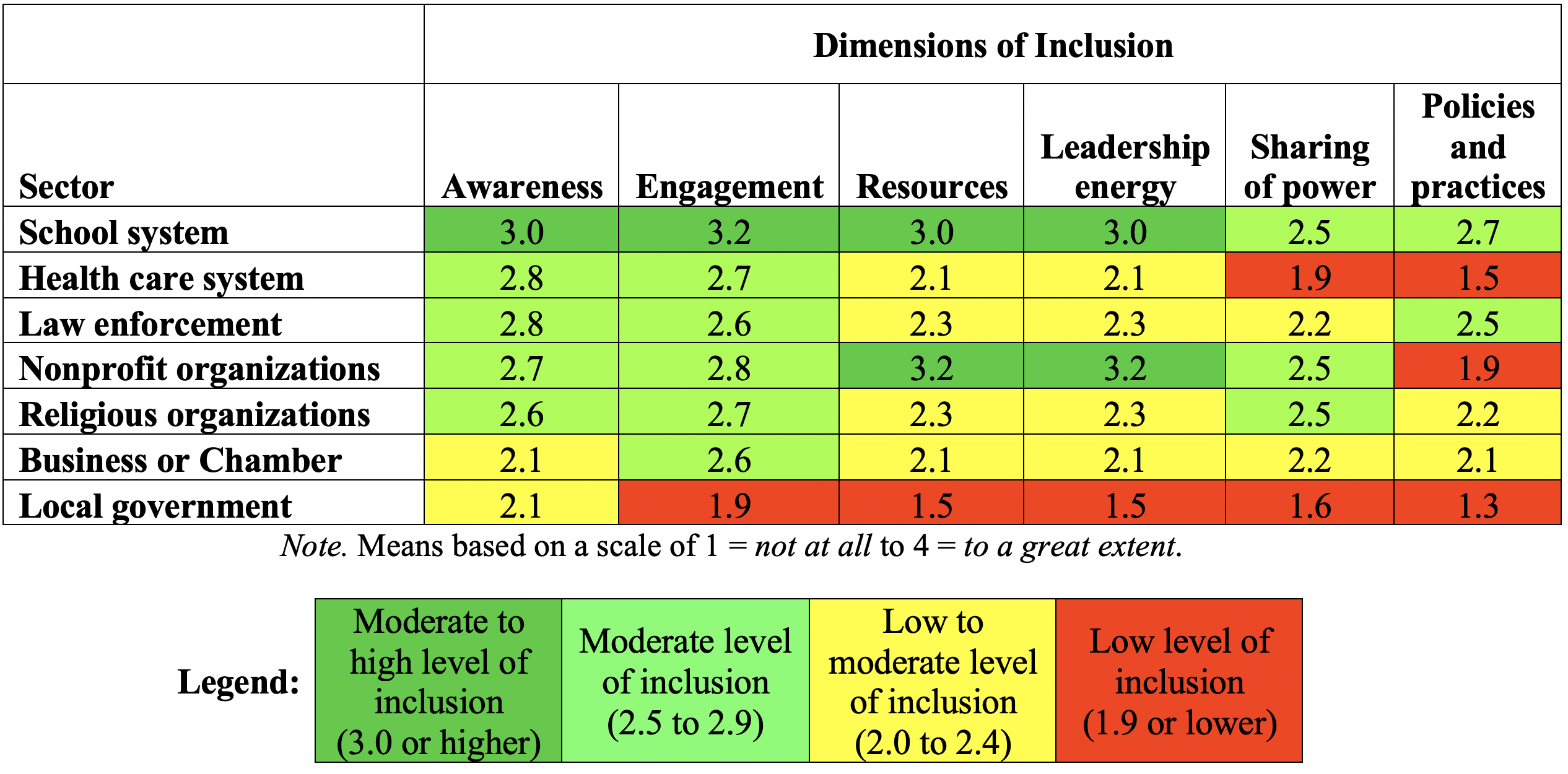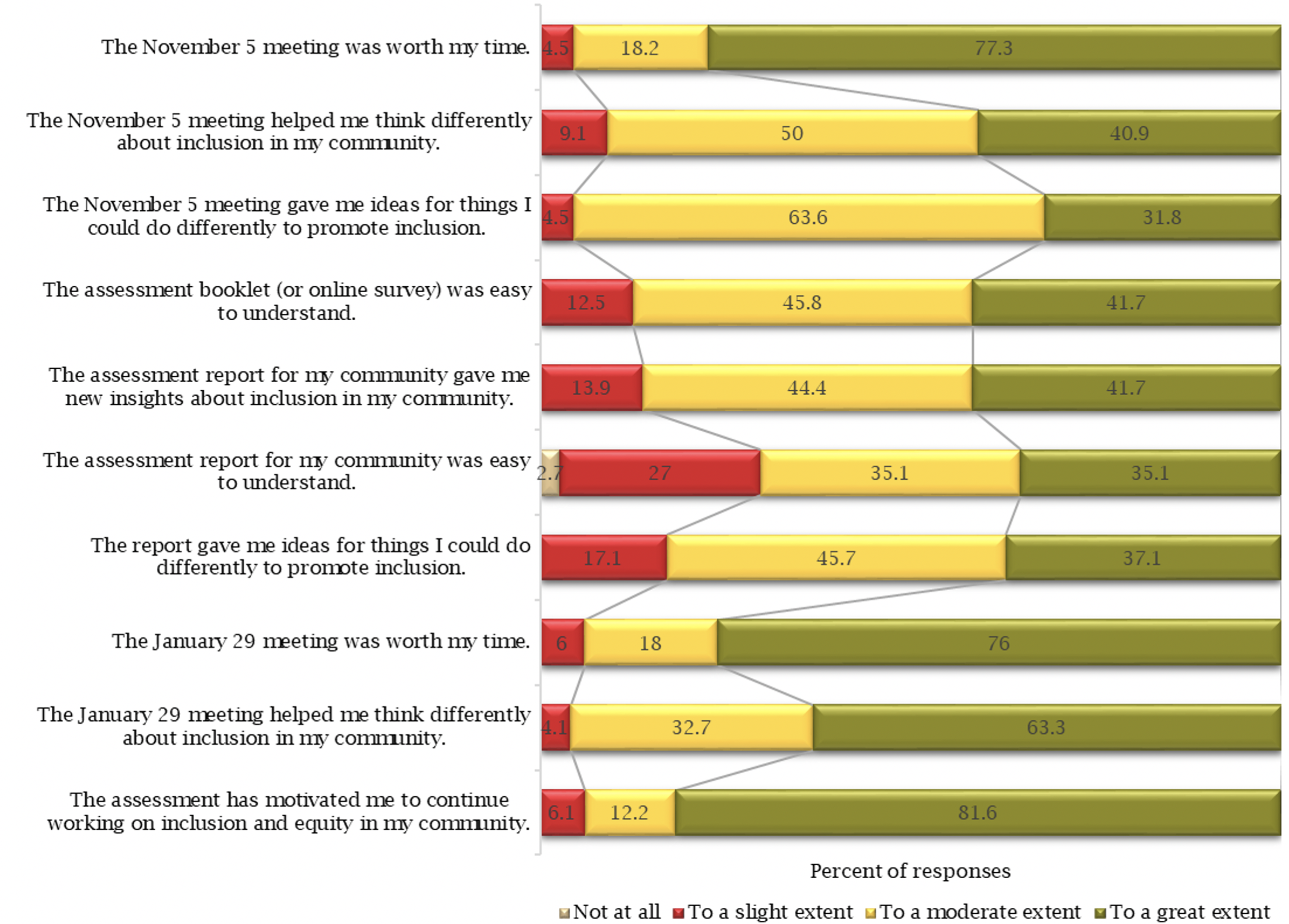 |
December 2020
|
December 2020 // Volume 58 // Number 6 // Tools of the Trade // v58-6tt1
Assessing Community Readiness to Engage in Diversity and Inclusion Efforts
Abstract
Social scientific research has demonstrated that increasing racial or ethnic diversity can reduce overall levels of social solidarity in a community. Yet many community development organizations, including Extension, are deeply committed to creating a broader sense of cohesion in rural communities. This article highlights a recent interagency effort, known as the Welcoming Communities Assessment, to assess a community's readiness for inclusion. The Welcoming Communities Assessment helps community members gain a baseline, action-oriented understanding of how inclusive different sectors of their community are for immigrants, refugees, and people of color. This article describes the assessment's context, design, analysis, and implementation.
Introduction
As noted by social capital theorist Robert Putnam, immigration and ethnic diversity can reduce social solidarity in a community, sometimes leading distinct racial or ethnic groups to "hunker down" among themselves (Putnam, 2007, p. 149). Yet many community development organizations, including Extension, are deeply committed to reducing this sense of "hunkering down" and creating a broader sense of inclusion in rural communities (Raison & Gordon, 2012).
This article highlights a recent interagency effort to assess and reflect on a community's readiness for inclusion. Community readiness is defined as the degree to which a community is ready to take action on an issue (Edwards et al., 2000). Assessing community readiness is important because it can help community members prioritize and sequence efforts to build and support inclusion.
Context of the Assessment
The assessment described here emerged from an existing initiative conducted by University of Minnesota Extension in collaboration with Region Nine Area, Inc. (RNAI), a nonprofit arm of the Region Nine Development Commission in south central Minnesota. With funding from the Blandin Foundation and participation of the Greater Mankato Diversity Council, an interagency team created a community cohort program called the Rural Equity Learning Community (RELC). The program brought together diverse stakeholders from six communities to share, examine, and explore inclusive best practices through education and relationship building. An issue identified by the learning cohort was the need to document the readiness of communities to engage in diversity and inclusion efforts. RNAI contracted with Scott Chazdon, who has expertise in community readiness measurement, to guide a team of people from several of the RELC communities in developing a user-friendly community assessment tool and process.
Designing and Conducting the Assessment
In spring 2019, Chazdon led the assessment design team through a series of online meetings to review a range of community readiness tools (Chazdon & Lott, 2010; Edwards et al., 2000; MacLellan-Wright et al., 2007; Western States Center, 2015), identify the dimensions of readiness most important to diversity and inclusion work in the region, and create a draft assessment.
The team decided to focus on six dimensions of inclusion, as shown in the left side of Figure 1. To keep the assessment short, the team chose three questions to measure each dimension of inclusion. Three is often considered the minimum number of items for construction of a factor or scale (Marsh et al., 1998). Following Wilkinson's field theory (Wilkinson, 1972), an innovative aspect of the assessment design focused on seven sectors of community life, as shown in the right side of Figure 1. The design team believed a deeper understanding of each sector would provide actionable information regarding which sectors were leading or lagging in their diversity and inclusion efforts.
Figure 1.
Dimensions of Inclusion and Community Sectors

In fall 2019, we tested the assessment when three new communities expressed interest in a second cohort program. This new program was renamed the Welcoming Communities Project, and the assessment was named the Welcoming Communities Assessment. We decided to use results from the assessment as baseline data to inform the design of each community's cohort program.
We created separate surveys for each of the seven sectors. The same questions were used, except for substitution of the relevant sector name in the question text. As an example, Figure 2 shows the assessment questions used to measure awareness of inclusion in the school system.
Figure 2.
Assessment Questions for Awareness Dimension in School System Sector

Residents from the three communities completed 223 assessments either at a face-to-face meeting in November 2019 or online after the meeting. We used a mixed-methods approach in the assessment, including numeric and open-ended survey questions as well as group discussion. Experienced facilitators led the group discussions, allowing participants to share stories that provided examples of situations they experienced.
Analyzing and Reporting
Each community received a complete report with detailed findings and a table (such as that shown in Figure 3) summarizing results across all dimensions of inclusion and sectors.
Figure 3.
Example of Overall Community Findings

In the results table provided to a community, a green, yellow, and red color scheme is used to show where inclusion is strongest and weakest in the community. The example shown in Figure 3 indicates that the school system in the community appeared to be on the leading edge of inclusion efforts. At the same time, all sectors of the community reported lower levels of inclusion in the dimensions of sharing of power and policies and practices. Moreover, respondents reported that local government had low to moderate awareness of inclusion but a low level of inclusion in the other dimensions.
Engaging and Moving Forward
Residents of the three communities gathered in January 2020 to hear their results and begin to set priorities (Moldaschel, 2020). The project team, including three Extension educators, designed small-group discussions to help each community prioritize its actions in each sector and build more inclusive practices. These discussions loosely followed the focused conversation approach (Stanfield, 2000). An evaluation of the overall process, conducted at the end of the January session (Figure 4), confirmed that the process was worthwhile for participants and encouraged them to think differently about inclusion in their communities.
Figure 4.
Evaluation Results

Note. Data represent 51 responses.
Conclusion
As once noted by Putnam, "The task of becoming comfortable with diversity will not be easy or quick, but it will be speeded by our collective efforts and in the end well worth the effort" (Putnam, 2007, p. 165).
The Welcoming Communities Assessment is an important tool for strengthening equity and inclusion efforts in rural communities. The assessment allows community members to gain a baseline, action-oriented understanding of how welcoming different sectors of their communities are for immigrants, refugees, and people of color. The process of conducting the assessments needs to be an engaged one, in which community members are brought together not only to conduct the assessment but also to reflect on the results.
Author Note
Correspondence concerning this article should be addressed to Scott Chazdon. Email: schazdon@umn.edu
References
Chazdon, S. A., & Lott, S. (2010). Ready for engagement: Using key informant interviews to measure community social capacity. Community Development, 41(2), 156–175.
Edwards, R. W., Jumper-Thurman, P., Plested, B. A., Oetting, E. R., & Swanson, L. (2000). Community readiness: Research to practice. Journal of Community Psychology, 28(3), 291–307.
MacLellan-Wright, M. F., Anderson, D., Barber, S., Smith, N., Cantin, B., Felix, R., & Raine, K. (2007). The development of measures of community capacity for community-based funding programs in Canada. Health Promotion International, 22(4), 299–306.
Marsh, H. W., Hau, K. T., Balla, J. R., & Grayson, D. (1998). Is more ever too much? The number of indicators per factor in confirmatory factor analysis. Multivariate Behavioral Research, 33(2), 181–220.
Moldaschel, D. (2020, March 3). Welcoming Communities Project moving to individual community groups. Sleepy Eye News. https://www.sleepyeyenews.com/news/20200307/welcoming-communities-project-moving-to-individual-community-groups
Putnam, R. D. (2007). E pluribus unum: Diversity and community in the twenty‐first century. The 2006 Johan Skytte Prize Lecture. Scandinavian Political Studies, 30(2), 137–174.
Raison, B., & Gordon, B. (2012). Using discussion methods to inspire diversity: Harnessing social & cultural capital. Journal of Extension, 50(5), Article v50-5tt7. https://www.joe.org/joe/2012october/tt7.php
Stanfield, B. R. (Ed.). (2000). The art of focused conversation: 100 ways to access group wisdom in the workplace. New Society.
Western States Center. (2015). Racial justice organization assessment. https://institute.coop/sites/default/files/resources/Western%20States%20Center%20-%20Racial%20Justice%20Organization%20Assessment.pdf
Wilkinson, K. P. (1972). A field-theory perspective for community development research. Rural Sociology, 37(1), 43.




